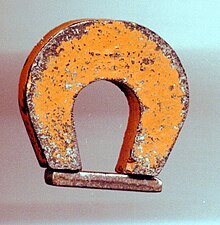
| Condensed matter physics |
|---|
 |
Ferromagnetism is a property of certain materials (such as iron) that results in a significant, observable magnetic permeability, and in many cases, a significant magnetic coercivity, allowing the material to form a permanent magnet. Ferromagnetic materials are noticeably attracted to a magnet, which is a consequence of their substantial magnetic permeability.
Magnetic permeability describes the induced magnetization of a material due to the presence of an external magnetic field. For example, this temporary magnetization inside a steel plate accounts for the plate's attraction to a magnet. Whether or not that steel plate then acquires permanent magnetization depends on both the strength of the applied field and on the coercivity of that particular piece of steel (which varies with the steel's chemical composition and any heat treatment it may have undergone).
In physics, multiple types of material magnetism have been distinguished. Ferromagnetism (along with the similar effect ferrimagnetism) is the strongest type and is responsible for the common phenomenon of everyday magnetism.[1] An example of a permanent magnet formed from a ferromagnetic material is a refrigerator magnet.[2]
Substances respond weakly to three other types of magnetism—paramagnetism, diamagnetism, and antiferromagnetism—but the forces are usually so weak that they can be detected only by lab instruments.
Permanent magnets (materials that can be magnetized by an external magnetic field and remain magnetized after the external field is removed) are either ferromagnetic or ferrimagnetic, as are the materials that are attracted to them. Relatively few materials are ferromagnetic. They are typically pure forms, alloys, or compounds of iron, cobalt, nickel, and certain rare-earth metals.
Ferromagnetism is vital in industrial applications and modern technologies, forming the basis for electrical and electromechanical devices such as electromagnets, electric motors, generators, transformers, magnetic storage (including tape recorders and hard disks), and nondestructive testing of ferrous materials.
Ferromagnetic materials can be divided into magnetically soft materials (like annealed iron), which do not tend to stay magnetized, and magnetically hard materials, which do. Permanent magnets are made from hard ferromagnetic materials (such as alnico) and ferrimagnetic materials (such as ferrite) that are subjected to special processing in a strong magnetic field during manufacturing to align their internal microcrystalline structure, making them difficult to demagnetize. To demagnetize a saturated magnet, a magnetic field must be applied. The threshold at which demagnetization occurs depends on the coercivity of the material. Magnetically hard materials have high coercivity, whereas magnetically soft materials have low coercivity.
The overall strength of a magnet is measured by its magnetic moment or, alternatively, its total magnetic flux. The local strength of magnetism in a material is measured by its magnetization.
- ^ Chikazumi, Sōshin (2009). Physics of ferromagnetism. English edition prepared with the assistance of C. D. Graham, Jr. (2nd ed.). Oxford: Oxford University Press. p. 118. ISBN 978-0-19-956481-1.
- ^ Bozorth, Richard M. Ferromagnetism, first published 1951, reprinted 1993 by IEEE Press, New York as a "Classic Reissue". ISBN 0-7803-1032-2.